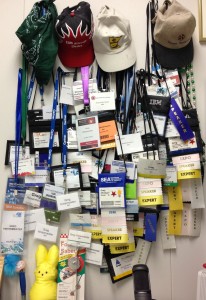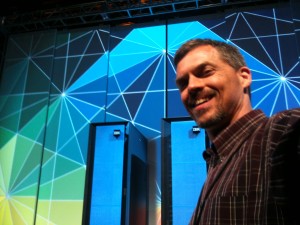This originally appeared in Power IT Pro blog…
Like you, I work in a fast-paced, high-tech business where I am constantly being challenged to increase productivity. For years this has involved multi-tasking across a large set of tasks that seem to constantly need my attention. While I feel I am quite effective at juggling multiple tasks at once, there are times I feel that the results, while complete, are not as satisfying as they could be. However, since the nature of our business holds up multi-tasking as the source of excellence and experience, the pattern has been accepted, and many times, required.
Recently I had an experience that began to challenge the very notion that “multi-tasking == better”.
Here is how it happened…
I’m sitting down to watch the season finale of Glee with my wife…beautiful thing…Netflix ;-). I had timed it just right…kids were asleep, wife was on the couch, and my very yummy evening dessert was freshly dished (heated home-made berry crisp bar with some really great French vanilla ice cream).
But it wasn’t just the ‘together time’ with the wife, the dessert, and Glee. I had my iPhone next to me, and even my laptop. I WAS SET! I clicked play, and my multi-sensory, multi-tasking late night experience started perfectly as planned.
And then the wife got up. WHERE DO YOU THINK YOU’RE GOING!?! I shout with my eyes (I’m good at that…especially when she’s walking away from me). She just hears the clink of the spoon and the pause of the show.
Dang it! I was so frustrated!
The experience instantly changed from a synchronized multi-tastic media blitz, to a time-wasting “watch the dessert melt while waiting for the missus” disaster.
I stared at my dessert in despair.
It started melting. Sadness.
I stared closer…
…it continued to melt…Amazing! I had never noticed it before:
The top of the ice cream was changing in real-time from a jagged mountain-scape into a smooth, soft pillowy cloud-scape. The berry crisp was causing the ice cream bottom to melt faster and created tiny fjords … ending in a micro sea of sweet deliciousness. The first spoonful was exhilarating! The textures I saw translated into a complex symphony playing across my tongue…complete with instruments of cold, warm, smooth, hard, sweet, tart…all within the first taste. The remaining bites were just as exhilarating…but different. As the melting continued, the texture changed, blending of sweet and tart increased, and each spoonful turned into a seamless tastexture that no amount of preparation could have produced.
I began to feel grateful for what I now refer to as “wifus-interruptus”. All I saw, felt, tasted, heard, smelled, savored…was all because I focused 100% on this one singular event. A multi-tasked version would have resulted in the dessert disappearing without barely tasting it, while at the same time a less enjoyable show with all the interruptions of glancing down at the dessert!
Then a sudden realization shook my core beliefs: Could my constant push to increase efficiency, experience, exposure, and excellence through multi-tasking actually be decreasing those very goals?
What if, instead, I focused 100% on one single thing at a time?
What if I took the time to dedicate all senses, all brain power, every curious and analytical fibre to experience everything that surrounds me like I just did eating that dessert?
What else would I notice that usually zips by without a neuron of recognition?
What delightful details evaporate before I can partake in their beauty?
What insight, skill, or invention escapes me because I constantly swap to the next of 18 things I’m trying to accomplish all at once?
I started to focus 100% on other things…
Did you know that the froth on a newly shaken glass of iced coffee bubbles like it’s alive…only to settle into a delicate blanket of protection over the liquid…preserving it for the perfect first taste?
Did you know a glass filled with iced coffee contains 1000 micro waterfalls? At least that’s what it looks like when the glass spontaneously starts sweating in the 90-degree summer air.
It was like I was given a sixth sense…focus. I wondered: Is this experience of omni-tasking, this 100% immersive focus of all senses into a single task, the key to unlocking a deeper, fuller, more satisfying experience? In my home? In my work? In everything?
I continued…
How about the pond and crick burbling in our walkout? It’s usually a background artifact filling the silent gaps between task switching. What if it was the foreground? The primary focal point? What would I absorb?
Did you know a chickadee stares at the water like it was the first time he’d seen such wonderful thing? Every time! “WOW! Look at that amazing, thirst-quenching river of life!”…he looks around…not frantic…looking for a friend? Lonely…he looks back: “WOW! Look at that amazing…” Did you know that a yellow finch seems so afraid at being eaten that every time he takes a drink he quick looks all around assuming it’s his last?
It was like I discovered a super-human power…
Did you know that 100% focus on your oldest son at the end of the day enables him to talk in a continual stream of consciousness? That through that kind of focus you can ask deeper questions, absorb his passions, likes, dislikes, and in the end show your love for him by just listening, reacting, and laughing?
~~~~~~~~~~~~
Now I’m wondering: Could omni-tasking help in other areas?
What if I focused 100% on my girls gymnastics training? Could we have deeper discussions on what the ropes feel like as they climb, arms only, in a pike position? Could they convey the feel of chalk on their hands as they spin the bars? What do they see as they flip across the floor?
What if I listened to my youngest? 100% focus. What would I learn from his crazy-smart brain? What insight would a 7 year old not-yet-jaded-by-assumptions-and-rules child have on a 42 year old too-distracted-by-everything-all-at-once-to-appreciate-much-of-anything brain?
What if I omni-tasked while writing music? What hidden gem would I discover? What deeper emotion could I share? What funnier lyric could I write?
What if I scheduled dedicated time throughout the day to omni-task on one work activity at a time? Would I marvel at what I accomplished? Would I find greater insight? Solve harder problems? Provide better leadership?
Lets get specific: As I leave work the day before, what if I identify just ONE thing to practice omni-tasking…and dedicate 2 hours to it? Heck, even 1 hour of 100% focus. What kind of solution or idea would appear at the end of that session?
Would I discover that through the self-driven pressure to multi-task I’m cheating myself…and everyone around me…from a deeper, better, happier, appreciative, wonder-filled, higher skilled, more inventive, kinder, better playing, love-giving, attentive, listening man?
~~~~~~~~~~~~
Omni-tasking. I might just have to spend 30 days experimenting…
Anyone want to join me?


